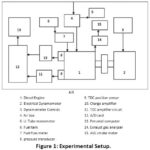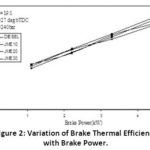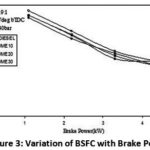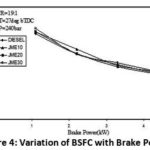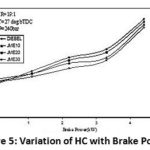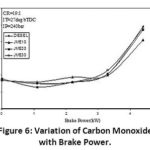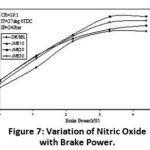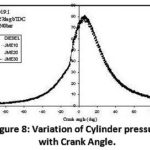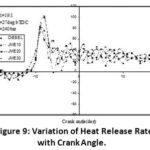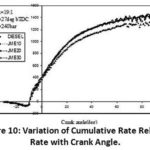Experimental Investigation on Performance and Emission Characteristics of Diesel - Jatropha Methyl Ester Blends Fueled Diesel Engine at Optimum Engine Operating Parameters
M. Venkatraman1 and G. Devaradjane2
1Department of Mechanical Engineering, Arulmigu Meenakshi Amman College of Engineering, Vadamavandal, Kanchipuram - 604 410 (India).
2Department of Automobile Engineering, Anna University, MIT Campus, Chrompet, Chennai-600 044 (India).
DOI : http://dx.doi.org/10.13005/msri/070209
Article Publishing History
Article Received on : 3 Jul 2010
Article Accepted on : 11 Aug 2010
Article Published :
Plagiarism Check: Yes
Article Metrics
ABSTRACT:
In the present investigation, tests were carried out to determine engine performance, combustion and emissions of a naturally aspirated direct injection diesel engine fueled with diesel and Jatropha Methyl ester and their blends (JME10, JME20 and JME30). Comparison of performance and emission was done for different values of compression ratio, injection pressure and injection timing to find best possible combination for operating engine with JME. It is found that the combined compression ratio of 19:1, injection pressure of 240 bar and injection timing of 27?bTDC increases the BTHE and reduces BSFC while having lower emissions.From the investigation, it is concluded that the both performance and emissions can considerably improved for Methyl ester of jatropha oil blended fuel JME20 compared to diesel.
KEYWORDS:
Diesel engine; injection timing; injection pressure; Jatropha oil; methyl esters
Copy the following to cite this article:
Venkatraman M, Devaradjane G. Experimental Investigation on Performance and Emission Characteristics of Diesel - Jatropha Methyl Ester Blends Fueled Diesel Engine at Optimum Engine Operating Parameters. Mat.Sci.Res.India;7(2)
|
Copy the following to cite this URL:
Venkatraman M, Devaradjane G. Experimental Investigation on Performance and Emission Characteristics of Diesel - Jatropha Methyl Ester Blends Fueled Diesel Engine at Optimum Engine Operating Parameters. Mat.Sci.Res.India;7(2). Available from: http://www.materialsciencejournal.org/?p=2383
|
Introduction
The increase in number of
automobiles in recent years has resulted
in great demand for petroleum products.Vegetable oils might
provide a viable alternative to diesel since they are renewable
in nature and environmentally friendly. The
use of vegetable oil in engines without any modifications results in
poor performance and emissions. Transesterification method is
used to reduce the viscosity of the vegetable oil and solves
the most of the
problems of raw vegetable oil.Transesterification is the reaction wherein the vegetable oil is transesterified with alcohol and the process
of removal of glycerol from
fatty acids. This esterfied vegetable oil is called
biodiesel.In the present investigation biodiesel was
prepared from jatropha oil and the blend with diesel in various volumetric
proportions the prepared blends were fueled in the engine test rig. The
performance, combustion and
emission characteristics were analysed on a four stroke single
cylinder direct injection diesel engine.The
properties of Jatrophamethylester and raw oil are compared
with diesel as shown in Table.1.
Experimental
Fig.1.shows the schematic line diagram of the experimental set up and its
specification are given in Table
.2. A Electrical dynamometer was used to apply the load on the engine. A
water rheostat with an adjustable depth
of immersion electrode was provided to dissipate the power generated.Tests were
carried out at various loads starting from no load to full load condition at a constant
rated speed of 1500 rpm. At each load, the fuel flow rate various
constituents of exhaust
gases such as Hydrocarbon
(HC), carbon monoxide (CO) and nitrogen oxides (NOx),
were measured with a 5-gas MRU elta exhaust gas analyzer. The analyzer uses the principle of non-dispersive infrared
(NDIR) for the measurement of CO and HC emissions while NOx measurement
was by means of electrochemical sensors. Combustion analysis was carried out by
means of an AVL pressure pick-up
fitted on the cylinder head and a TDC encoder
fixed on the output
shaft of the
engine. The pressure and
the crank angle signals were fed to a pentium
personal computer. Various combustion parameters like heat release rate, cumulative heat release rate
and peak pressure and its accurance were obtained
using data acquisition system. The engine was first operated with diesel
oil to generate the baseline
data followed by Methyl Esters
Jatropha and their
blends such as JME10, JME20 and JME30 blends.
Results and
Discussions
Testing were carried out at different compression ratio, injection timing and injection pressure and its details have been mentioned in Table 3. At injector opening pressure 200bar and220bar and injection timing of 21°bTDC and 24°bTDC and compression ratio 17.5:1 and 16:1.
Table 1: Comparison of Biodiesel Properties with Diesel.
| Properties | Diesel | Jatropha oil | Bio-Diesel (Jatropha Methyl Ester) |
| Cetane No. | 45 – 55 |
41
|
52
|
| Density (kg/m3) | 821 |
907
|
881
|
| Viscosity (cSt) | 3.52 |
36.9
|
5.12
|
| Calorific value (MJ/kg) | 43 |
41.1
|
41.6
|
| Flash point 0C | 48 |
276
|
152
|
| Oxygen % w | 1.19 |
11.06
| 10.97 |
Table 2: Specifications of Engine.
were tried for diesel and different biodiesel blends but from the investigation, it was found that the performance and emission was very poor. Further the engine were set to run at a higher compression ratio of 19:1, advanced injection timing of 27°bTDC and higher injector opening pressure of 240bar it arrives at the optimum range operating parameters for diesel and jatropha methyl esters JME20. It was found that (JME20) it gives better performance and emissions for the optimized operating parameters.
Fig. 2 shows the variation of brake thermal efficiency with brake power for different fuels. The maximum brake thermal efficiency obtained is about 30,9% for JME20 and 30.1% for diesel. An increase in thermal efficiency is due to percentage of oxygen presence in the biodiesel and a rapid change in combustion behaviour of the blend. The addition of JME20 with diesel changes reduces ignition delay and reduces the burn duration. Hence the injected fuel completes its combustion closer to the TDC and shorter than diesel baseline. The increase in air entrainment and rapid release of heat from the first stage of combustion could be the additional reason for the higher brake thermal efficiency JME20.
Table 3: Operating Parameters Considered in the Present Investigations.
| % Load | 0,25,50,75,100 |
| Speed (rev/min) | 1500 |
| Compression ratio | 16:1,17.5:1,19:1 |
| Injection Timing°bTDC | 21,24,27 |
| Injection Pressure(bar) | 200,220,240 |
Fig.3 shows the variation of brake-specific fuel consumption with brake power for different biodiesel blends.It can be observed that the bsfc of 0.273 kg/kW-hr was obtained for diesel and 0.27 kg/kW-hr for JME20.This is due complete combustion of JME20 because of presence of high cetane of JME as a result lower BSFC of JME20.
Fig.4. From the results it is found that JME20 offers comparatively lower BSEC than the other fuels. This is due to better combustion of JME20 due to presence of high Cetane of JME. JME30 fuels are containing higher proportions of JME and this reduces the heat content of fuel. This may be the main reason for higher BSEC of this fuel.The presence of lower fraction of JME enhances the combustion behaviour of diesel and releases its heat within a shorter duration than the diesel operation. This is the main reason for lower BSEC of JME20.
Fig.5.Shows the variation of hydrocarbon for different biodiesel blends at rated speed with respect to brake power. Diesel offers the maximum rate of hydrocarbon emission 36ppm among the tested fuels. Other fuels are offering relatively lower HC emissions due to the presence of high cetane of JME. The addition of JME with diesel fuel enhances the combustion of fuels and improves better reaction with the air presence inside the cylinder. The higher compression ratio, injection pressure and more advanced injection timing helps to provide clean combustion than the other operating parameters. Hence JME blended fuels perform better at this setting and completes its combustion and liberates its heat in shorter duration. This may be the additional reason for lower HC emission of JME blended fuels.
Fig.6.Shows the variation of carbon monoxide emissions of various JME biodiesel blends with brake power. From the figure it is observed the CO emissions of JME
are lower than the standard diesel fuel. The reason for the lower CO emission
of JME blends are due to the high cetane number of fuel, better combustion,
shorter duration of combustion and better spray.
Also due to higher compression ratio,
injection pressure and injection timing the combustion of the charge
occurs in a shorter duration. Hence more heat release occurs and increases the cylinder
temperature, as a result the whole
mixture are combusted fully
without leaving carbon monoxide. In addition the presence of molecular oxygen
helps to combust
the fuel with less emission.
Fig.7. From the figure
it is observed that JME blended fuels offers comparatively higher NOx emission than that of standard diesel.
This is mainly due to the presence of high cetane
fuel in a blend and higher compression ratio and higher injection pressure.
Generally bio-fuel are possessing fewer unsaturation in the molecules.This cause rapid generation of
intermediate compounds and
consequently the mixture
liberates heat in a shorter duration of combustion and hence
it offers higher combustion temperatures and promotes the higher NOx formation.
Fig.8.Shows the variation of pressure with crank
angle for different jatropha methyl
ester biodiesel blends and diesel at full load. The peak pressure of JME20 is slightly higher
than that of neat
diesel operation. This is the main reason for better thermal efficiency of this fuel than the reference fuel. The presence of high cetane biofuel
in a diesel causes better combustion
and liberates more heat in a shorter duration. This is the main reason for high
peak pressure of this blend JME20.
Fig.9.Shows the variation of heat release rate with crank angle
for different jatropha methyl ester biodiesel blends and diesel at full load.
It is seen that the height
of premixed phase of combustion decreases with addition
of JME proportions in the
blend. More JME blends offers comparatively lower premixed phase and higher diffusive
combustion phase. This is due rapid production of intermediate compounds in high JMEblends.
Fig.10.Shows the variation of cumulative heat release rate with crank angle for different
jatropha methyl ester biodiesel blends
and diesel at full
load.It is noticed
that the cumulative heat release rate
is decreased for JME20(1432J) compared to diesel(1458J).This is due to higher
exhaust gas temperature and NOx emission.
Conclusion
Following are the conclusions based on the experimental results obtained while operating single cylinder diesel engine fuelled with biodiesel from Jatropha oil and their blends. Jatropha Methyl esters can be directly used in diesel engine without any modifications.The maximum brake thermal efficiency is found to be JME20 in 27ºbTDC and 240bar at compression ratio 19:1. It is found that the combined increase of compression ratio, injection timing and injection pressure increases the BTHE and reduces BSFC while having lower emissions.Good mixture formation and lower smoke emission are the key factors for good CI engine performance. These factors are highly influenced by viscosity, density, and volatility of the fuel. For bio-diesels, these factors are mainly decided by the effectiveness of the transesterification process. With properties close to diesel fuel, bio-diesel from Jatropha oil can provide a useful substitute for diesel thereby promoting our economy. Finally it can be concluded that JME20 could be used as alternative fuel for operating CI engine at compression ratio of 19:1, higher injector opening pressure of 240bar and advanced injection timing27ºbTDC with less emission of CO and HC and better engine performance.
References
- J.Patterson and K.Hellgardt, “Experimental Study of DI Diesel engine performance using Three different Biodiesel fuels” SAE 2006- 01-0234 (2006).
CrossRef - P.K.Sahoo and L.M.Das “Combustion analysis of jatropha,Karanja and Polanga based biodiesel as fuel in a diesel engine” Elsevier-Fuel. 994-999 (2009).
CrossRef - Deepak Agarwal and Avinash kumar Agarwal “Performance and emission characteristics of Jatropha oil (preheated and blends) in a direct injection compression ignition engine”Elsevier Applied Thermal Engineering. 2314-2323 (2007).
CrossRef - F.K.Forson and E.Hammond-Donkoh “ Performance of jatropha oil blends in a diesel engine” Elsevier-Renewable Energy. 1135- 1145 (2004).
CrossRef - Y.V.Hanumantha Rao and A.V.Sita Ramu Raju “Performance and Emission Characteristics of diesel engine with methyl ester jatropha oil and its blends”Int Journal of Energy Management 20 (2009).
CrossRef - B.Muralikrishna and J.M.Mallikaarjuna “ Properties and performance of cotton seed–diesel blends as a fuel for compression ignition engines” Journal of Renewable and sustainable Energy (2009).
- Sukumar Puhan and G.Nagarajan “ Combustion, performance and emission characteristics of a DI CI engine using biodiesel with varied fatty acid composition” Int.J.Renewable Energy Technology (2009).
CrossRef - Xiangang and Keiya Nishida “Experimental and analytical study on biodiesel and diesel spray characteristics under ultra-high injection pressure” Elsevier Int.J.Heat and Fluid Flow (2010).
CrossRef - G.Lakshminarayanarao and K. Rajagopal” Combustion Analysis of Diesel engine Fueled with jatropha oil methyl esters – Diesel blends “Int Journal of Green Energy (2007).
CrossRef - R.Anand and S.Velmathi “ Performance and Emissions of a Variable Compression Ratio Diesel Engine Fueled with Biodiesel from cotton seed oil”ARPN Journal of Engineering and Applied Sciences (2009).
- M.Pandian and M.Udayakumar “ Influence of Injection Timing on performance and emission characteristics of Naturally aspiraed Twin cylinder CIDI Engine using Bio-Diesel blend as fuel”. Int.J.Recent Trends in Engineering (2009).

This work is licensed under a Creative Commons Attribution 4.0 International License.
 Material Science Research India An International Peer Reviewed Research Journal
Material Science Research India An International Peer Reviewed Research Journal

